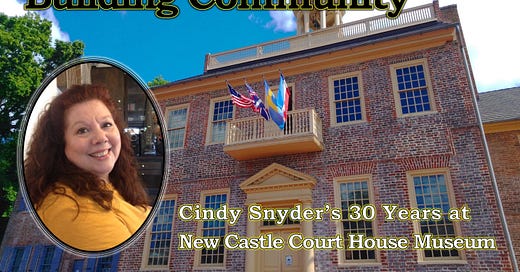Cindy Snyder's 30 Years Holding Court
Chatting with the Court House Museum supervisor (and a few friends) as she Retires
New Castle Court House Museum is - both literally and figuratively - the center of a huge portion of New Castle and Delaware’s civic and cultural life. This extends from the swearings-in of the city’s elected leaders, to it being a primary location for many big annual events like Separation Day, to its core role as a curator of our history and shared experience. The Court House’s beautiful cupola was even the original center point from which Delaware’s uniquely round northern border was drawn (though that point is now at Broad Dyke).
For three decades, Cynthia Snyder - known to most simply as Cindy - has been at the center of this key institution. And while it has, of course, not seen any legal trials for quite some time, it has very much been her Court. As the state museum’s site supervisor and a community leader beyond its walls, Snyder has leveraged its location and heritage to enrich the community and build partnerships. These have, in turn, enriched the museum and built a legacy set to endure well past her tenure.
A graduate of the University of Delaware whose focus even there was on history education, Snyder’s career has been one of distinguished service. “She has,” as noted in a recent Dept. of Historical & Cultural Affairs (HCA) statement honoring her, “received the Outstanding Service to the Community and the Governors Achievement Award from the state,” and the American Association for State and Local History’s (AASLH) Leadership Award in History.
Outside of New Castle Court House (NCCH), Snyder has been a long-serving board member of New Castle Community Partnership, and co-chair of A Day in Old New Castle, a beloved annual event heavily focused on history education, for the better part of a decade. Most recently, Snyder helped to found the relatively new Battell and Read Chapter of the Daughters of the American Revolution, which she continues to serve as an officer.
As her answers below indicate, however, Snyder has not sought influence or accolades. Her focus is - even days before retirement, when we completed this interview - on the work of building community around our shared history.
Lastly, in her long career, Snyder has worked with many people. And, well, they had some thoughts to share too, which you will find interspersed below…
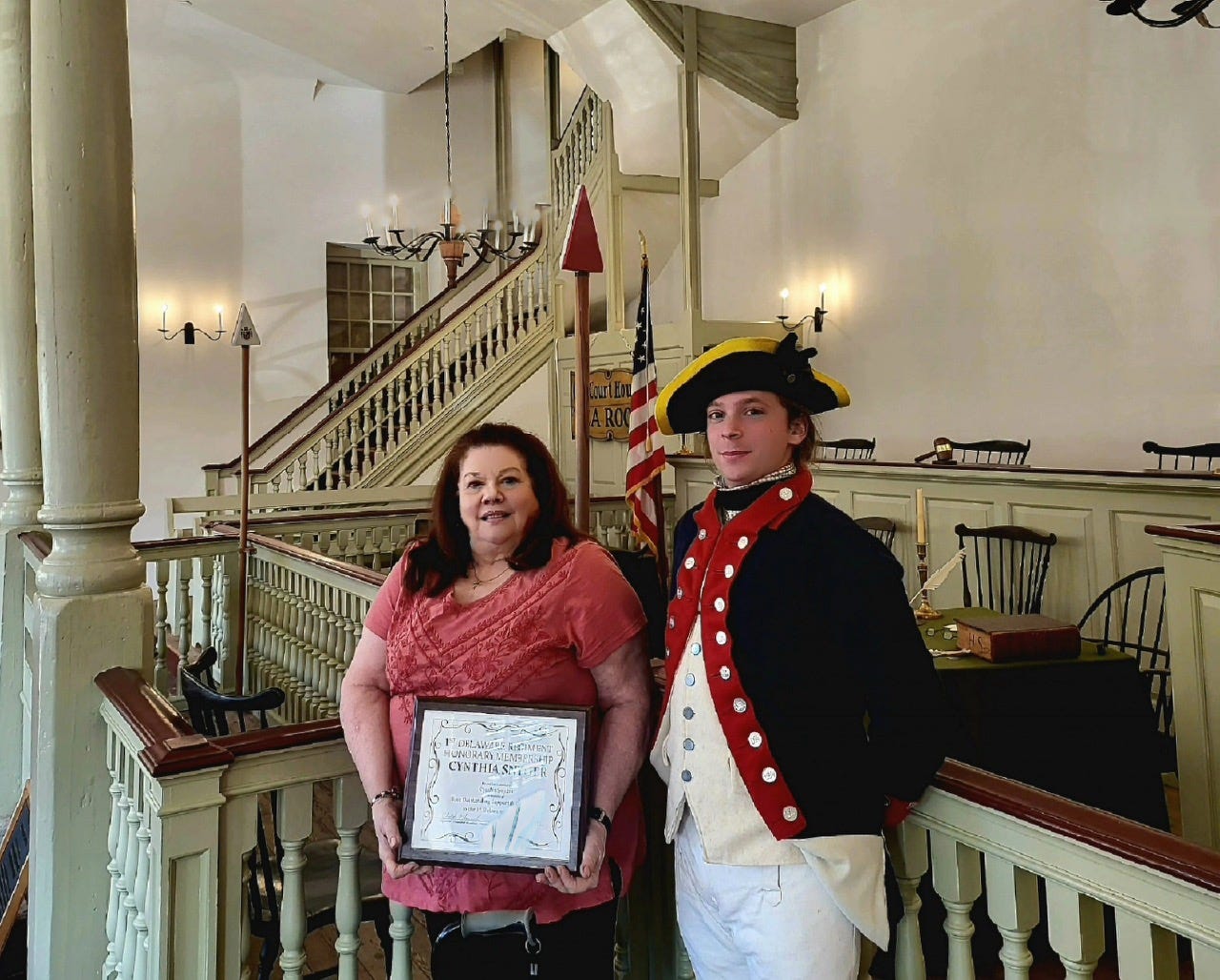
Cindy Snyder in Her Own Words… And Others’
City Topics (CT): New Castle Court House is both a state museum and also the center of a great number of local activities. How do those functions complement each other? Are they ever in conflict?
Cynthia Snyder (CS): The Court House has always been the center of civic life and public events, [back to] when it was a working courthouse. I think they both complement each other. The main purpose of the museum is communicating historical information, and the events can serve the same purpose. Both relate some topic of history to the public. Even our big events, Day In Old New Castle (DIONC) and Separation Day, are history based.
Other events at NCCH like weddings, political meetings, community meetings, speakers, etc., are all a continuation of activities that would be held in a courthouse or state building. I think they do compliment NCCH civic and event functions. We are careful in scheduling activities at the Court House so that we can always be open to the public for our core purpose- a museum , and still handle other scheduled activities. Usually, we find a way to do both at the same time.
CT: Who is the institution’s target constituency?
CS: We have two targets: educational tours and programs for schools Pre-K thru college, and the other target is the general population. We find what the visitor likes and try to create that experience. We find our typical visitor’s age range is 30’s-80’s, with the majority toward their 50’s-60’s. We try to make the information we give relevant to all, always concentrating on areas the visitor may be most interested in, and introducing controversial subject matter too.
“Cindy has been with the Court House for thirty years and I am not sure there is anyone else who cares or knows more about the Court House than Cindy. She is a huge part of the community and I am sure even though she won’t be working at the Court House she will still be involved... She has been a wonderful supervisor and cares deeply about her staff as people. I hope her legacy at the Court House continues [and is] built upon as the Court House grows into the future.”
- Juliette Wurm, NCCH Lead Historical Interpreter
CT: Are there events or projects the Court House has been a part of over the years that especially stand out to you as historic or meaningful?
CS: Yes, two main events that are the most historic and meaningful to me are A Day in Old New Castle (DIONC) and Separation Day, and I think Separation Day is more important. It’s the acknowledgment of the day that the Delaware State was born, by the signing of the Separation Resolution by the Colonial Assembly in 1776. By separation from Great Britain and Penn’s proprietary of Pennsylvania, we became our own sovereign state. It was Delaware’s own Declaration of Independence. It all happened in the Assembly Room of the Court House. The Court House served as both a court and the seat of our elected Assembly. What could be more important for Delaware than that! I often tell visitors that our Court House is to Delaware as Independence Hall is to the nation, a sacred place where our freedom started.
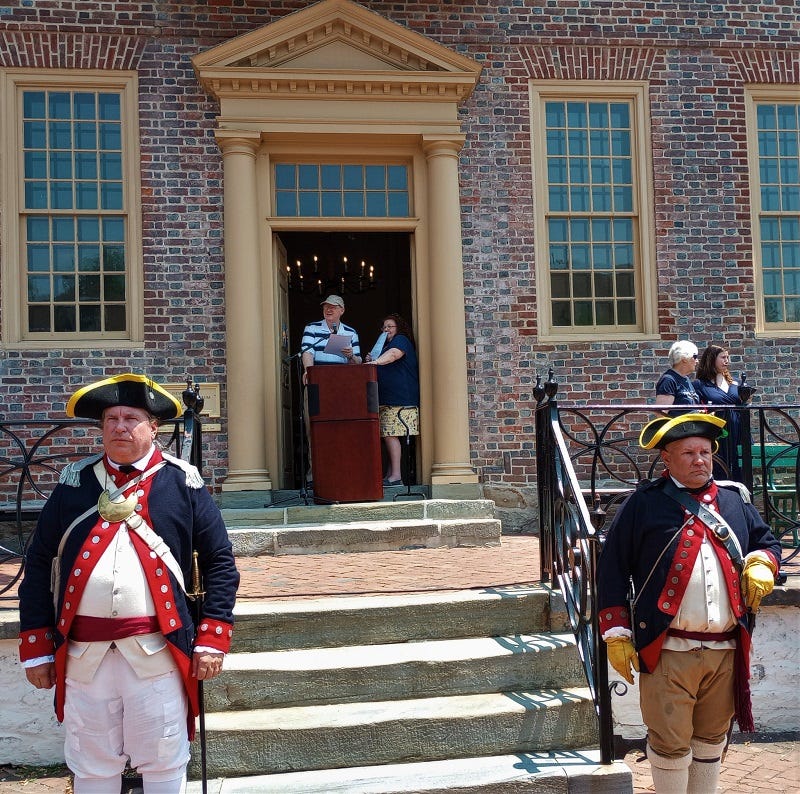
DIONC is a unique, yearly activity that is another defining event of New Castle. 2024 will be our 100th anniversary year of the oldest running house and garden tour in the nation. The event itself is a chronicle of the history of our town, its changing ideas and technology, and the ebb and flow of community participation, commitment and pride that has spanned 100 years. What started as a church charity event to show off historic buildings and the elite homes of the town, has morphed into a more community-oriented event highlighting many aspects of New Castle’s history and community life.
I think both these events are at the core of what New Castle represents, the continuity of the long history of a town and its changing community.
“I met Cindy more than 10 years ago as a newly elected senator. What I love most about Cindy, that captures your attention immediately, is that amazing smile. And when you make a friend with Cindy, you make it for life. I have enjoyed … her knowledge of our Court House, her knowledge of her job, and… the rich history of our state. There is something about Cindy that is just warm and welcoming. As a new senator she made me feel like I was in a great spot to be. And I think that for all the years she has served the State of Delaware, she too was in the right spot… I wish her the best success. I think every person lives for this moment. And when they get there, it just opens up the ability for them to give back [even] more… and I think that Cindy’s going to continue to be a great pillar of our society. She’s an awesome lady.”
- Nicole Poore, Senator for State District 12, incl. New Castle
CT: Three decades is a long time, especially in public service. How has the Court House changed through the years you’ve been there?
CS: Over the span of thirty years, I have seen great changes in the way we communicate historical information to the public. Like the previous question, generational changes in attitudes, experiences, technology, more open access to information and public expectations have changed how we conduct tours, educational programs, and exhibits at the museum.
The public now want an interactive and connecting experience when they visit a museum. The questions they want answered are, “how does this relate to me personally?” and, “why is this information important for me to know?” When you can show the visitor that decisions or events of the past can still affect the present and consequently how this affects the individual in his life today, it has more meaning. We need to make the stories more relatable, about people like you and me, the choices they had to make , and how it affected their lives and others. Sometimes it even affects generations to come.
Visitors don’t want to read a lot of text. They want visual information, interaction, hands-on, digital activities to make it a more personal and complete experience. We have had to change with the times and technology to keep the public’s interest and the type of experience they want now.
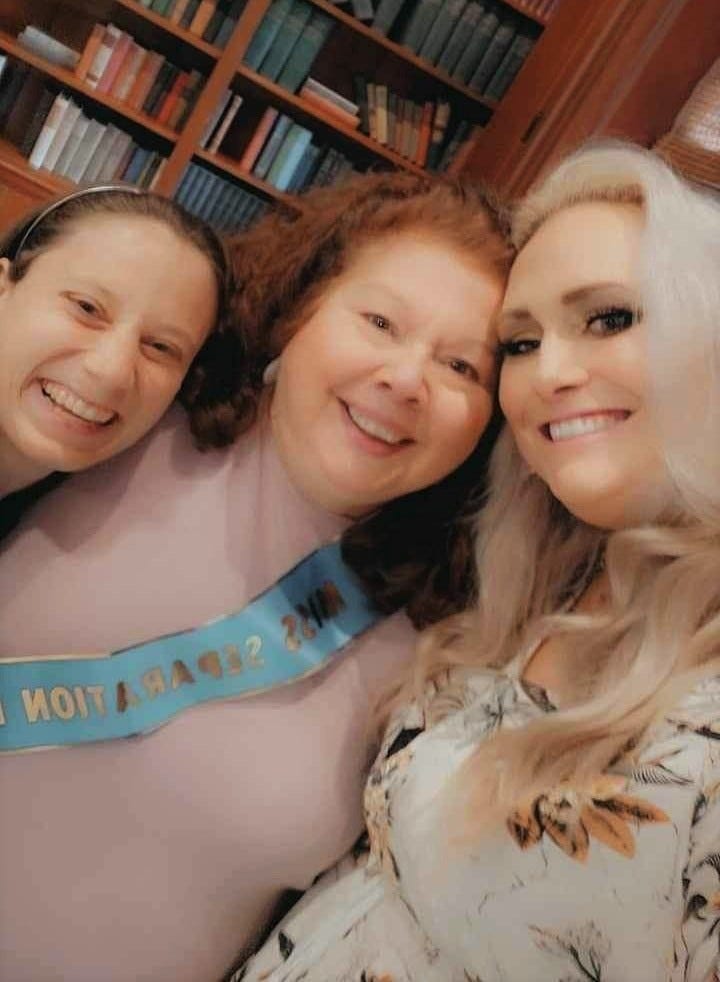
CT: The proliferation of digital technologies, and our culture’s ongoing reckoning around what voices and topics have been explored or ignored in our history have challenged many cultural institutions. How has the Court House adapted to these changes?
CS: Yes, advances in technology and the changing thought in how all voices in history need to be heard have made great changes in all museums, ours included. Today, exhibits are no longer static. Items and areas of participation and interactivity for the visitor are included. It may be digital, physical, visual, and hands-on to name a few. We have added this to our exhibits, displays and educational and public programs at the Court House. Limitations to what you can do always come down to funding.
Our history is no longer seen as just the history of “old white men,” but the combinations and inclusion of all people- gender, race, ethnicity, religion, life-style orientation and personal beliefs. The list can go on and on. All are part of our human community. We have touched on all these subjects in our exhibits, programs, webinars, social media, and tour programs.
“Cindy has always been the essential one, whether providing outstanding
service to the public or helping her New Castle neighbors…
She has made things happen and never sought the spotlight.”
- Russ Smith, inaugural site supervisor of First State Historical National Park
(of which NCCH is a partner site) and former New Castle City Councilman
CT: Though often behind the scenes, you are involved in the life of New Castle well beyond the Court House, particularly through the Community Partnership. Is there a single project that you are especially proud to have worked on over the years?
CS: I am sorry, I can’t pick a favorite. All are very important to me. But I will say that what I find in all events I participate in or the organizations I work with is the pleasure of giving back to the community and working with others to do something good or needed for the community. Whether sharing our historical past at Sep Day or educating the public on the changing community at DIONC or working for the Partnership to provide services for the City and community, it all has to do with what can I do to help.
I do love A Day in Old New Castle. I’ve co-chaired that event since 2014 and served on the Committee probably another 10 years before that. I worked on the Separation Day Committee from 1993 until about 2012. I think both events are signature events for New Castle and hope they continue.
CT: What inspires you to devote so many hours to creating partnerships, organizing events, and making yourself – as Russ Smith has called you – “the essential one?”
CS: What inspires me to do what I do, is that I love this town and the people in this community. There are many generous, hard-working people in New Castle that volunteer their time and talents to make New Castle an enjoyable place to live and visit. That is what inspires me.
“I have volunteered alongside Cindy Snyder for many years through ADIONC, NCCP and other events and activities. I have always been amazed at her energy, passion for this city and historical preservation, and effectiveness at getting things done. I truly cannot express in a few words how exceptional Cindy is in everything she does except to say that I have always called her ‘my hero.’ She chuckles when I say it to her, but after all these years I hope she knows it is a genuine expression of admiration for her. It is an honor to be her friend and peer.”
- Judie Baldini, DIONC co-Chair and NCCP Executive Committee Member
CT: Is there an institution or location in town other than the Court House that you especially enjoy and would recommend as an essential stop?
Yes, the Dutch and Amstel Houses, owned by the New Castle Historical Society, and the Read House, all give you a wonderful perspective on a time and place in our history and the people who were involved.
Our historic churches provide the history of our faiths through the generations.
When walking along the river path, you can contemplate the importance of the Delaware River. The River is the reason why we have a New Castle here.
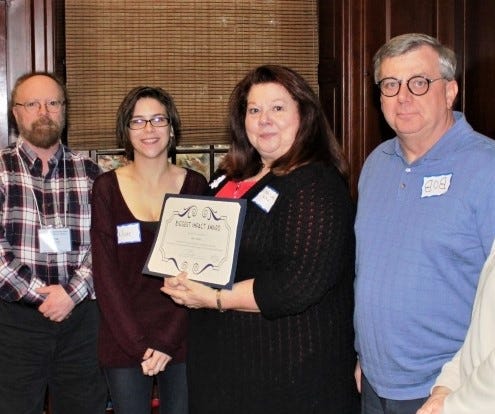
“I have worked at the Courthouse for 5 years now, with Cindy [and] she is the absolute best boss I have ever had in my career! She is simply wonderful… excellent at delegating, taking command of a room, a useful source, treats everyone respectfully, a wealth of knowledge herself, and just an overall incredible person. I am a lucky person to have both known her in the professional sense, and after all these years as a fellow human. I cant say enough good about Cindy Snyder, and she will be dearly missed at the Courthouse Museum.”
- Kimberly Fritsch, NCCHM Historical Interpreter
Sincere thanks to Cindy Snyder for taking the time to share her thoughts with us! And thanks also to her friends and colleagues who eagerly responded to requests for their thoughts on (and photos from) her many years of service and well-earned retirement.
This story will also be available in print in the The Weekly.

